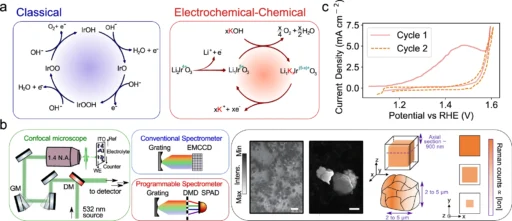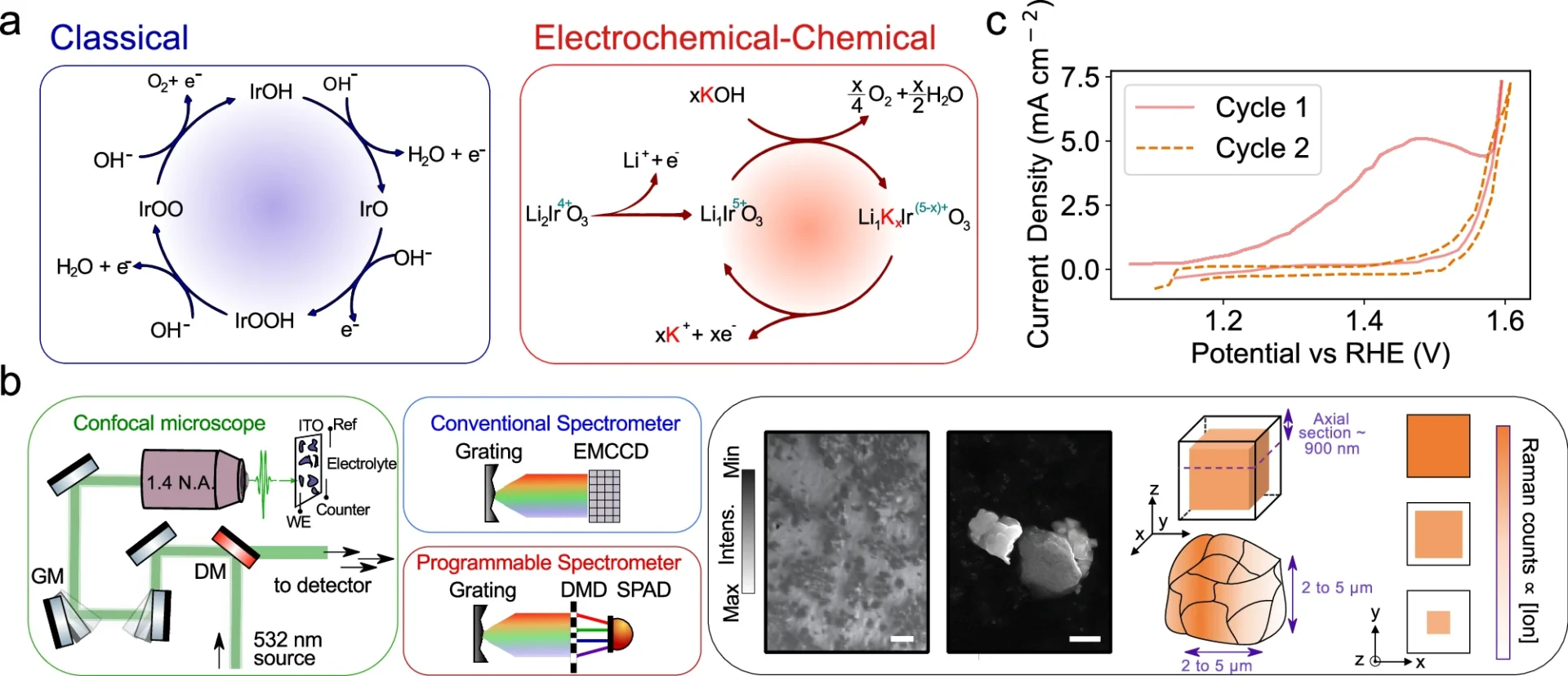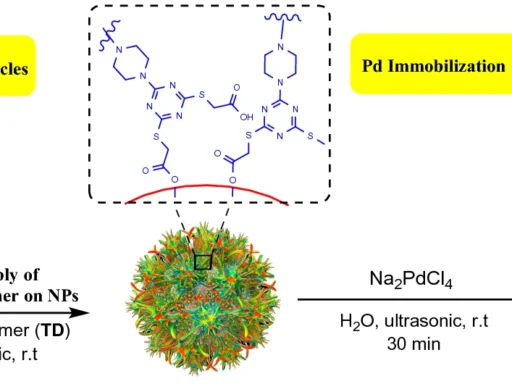Table of Contents
Preface:
The Oxygen Evolution Reaction (OER) is essential in renewable energy systems, particularly in water splitting, where it facilitates the generation of oxygen from water. Nonetheless, despite its importance, OER is a multifaceted process comprising numerous reaction stages and intermediate products, rendering comprehensive understanding difficult. In this context, high-speed compressive Raman imaging is relevant. This advanced method is illuminating the complexities of OER, uncovering simultaneous reaction pathways that were previously challenging to detect. Spontaneous Raman-imaging setup and agglomerate particles imaged.
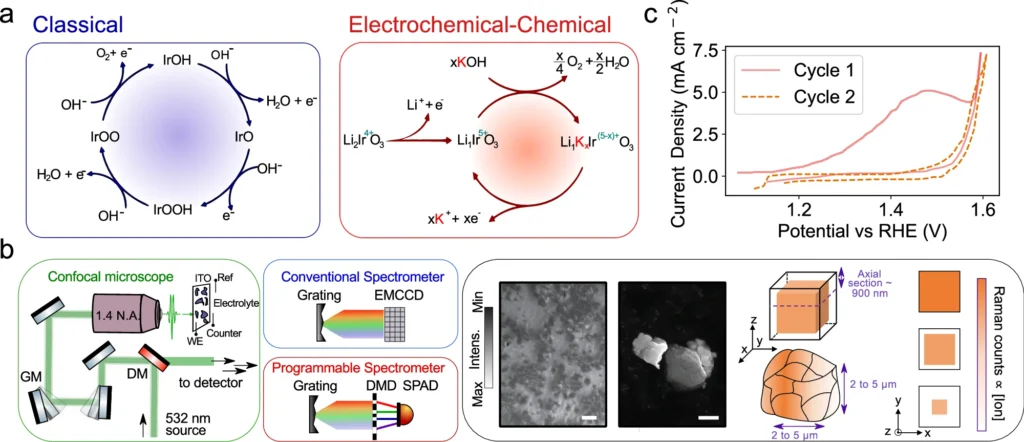
Comprehending the Oxygen Evolution Reaction (OER):
The Oxygen Evolution Reaction (OER) is a fundamental half-reaction in electrochemical processes, including water electrolysis, fuel cells, and metal-air batteries. It entails the dissociation of water molecules (H₂O) into oxygen (O₂), protons (H⁺), and electrons (e). The procedure may appear straightforward; yet, it is a complex, multi-step reaction that necessitates considerable energy to surmount reaction barriers. Due to this complexity, OER efficiency is a primary emphasis in the advancement of superior catalysts and energy conversion technologies.
What significance does this matter have? In renewable energy systems, the Oxygen Evolution Reaction (OER) facilitates the generation of oxygen essential for hydrogen production, which fuels fuel cells. Enhanced OER processes directly influence the efficacy of these systems, advancing us toward a sustainable energy future. Raman signatures of the different phases.
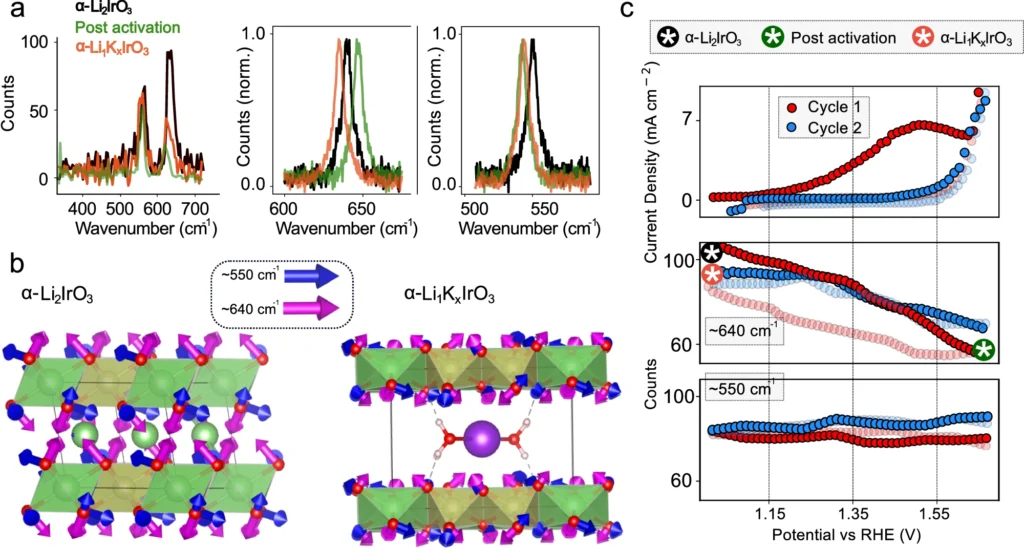
Overview of Raman Imaging:
It is an effective technique for elucidating molecular interactions. In contrast to conventional imaging techniques, Raman spectroscopy provides chemical signatures of substances by examining the scattering of light caused by molecular vibrations. This method enables scientists to observe material alterations during reactions.
Nonetheless, conventional Raman spectroscopy possesses limitations, especially in monitoring rapid, real-time events such as the oxygen evolution reaction (OER). This is where high-speed compressive Raman imaging transforms the landscape. Streamlining data collection into expedited, more efficient sequences, facilitates real-time monitoring of dynamic electrochemical reactions with high spatial and temporal resolutions.
Why does high-speed compressive Raman imaging represent a paradigm shift?
The ability to visualize reactions in real-time is critical for understanding the OER’s precise mechanisms. Conventional methods either lack the requisite speed or resolution to accurately record rapid, simultaneous reactions. High-speed compressive Raman imaging integrates the advantages of swift data acquisition with intricate, high-resolution visuals. This enables researchers to concurrently monitor several reaction pathways, a capability that was previously unattainable.
This new development makes it easier to keep an eye on how well different catalysts work during OER and how different reaction intermediates change over time. It resembles the ability to observe a cinematic representation of the chemical process rather than merely viewing still images.
Concurrent Pathways in Open Educational Resources: What Are They?
In OER, the reaction may follow various pathways before generating oxygen gas. We refer to these as concurrent pathways, which can occur simultaneously. Conventional approaches fail to capture all of these channels at the same time, frequently overlooking critical information that could enhance the reaction.
By comprehending these simultaneous paths, researchers can devise superior catalysts that enhance the most efficient route while inhibiting less advantageous events. It resembles traversing various pathways to a destination—you aim to identify the quickest, most energy-efficient route.
How Raman Imaging Reveals Simultaneous OER Pathways:
Rapid compressive Raman-imaging possesses the distinctive capability to simultaneously capture these OER routes in real-time. Employing rapid data collection methods enables researchers to observe the concurrent progression of various components of the reaction. This facilitates a comprehensive knowledge of the coexistence and evolution of various reaction intermediates during the OER process.
Recent research employing this technique has demonstrated that OER frequently encompasses multiple competing and overlapping pathways rather than a single route. Understanding this intricacy is essential for enhancing the reaction’s energy efficiency. Operando Raman-imaging and gas bubble imaging.

The Experimental Configuration for High-Speed Compressive Raman-Imaging:
The experimental configuration for high-speed compressive Raman-imaging comprises several essential components. A high-performance Raman spectrometer is essential for obtaining comprehensive chemical information. Sophisticated computational methods integrate with this to streamline the data collection process and facilitate expedited imaging.
An electrochemical cell synthesizes catalysts for the oxygen evolution reaction (OER). We meticulously regulate the reaction environment to guarantee reproducibility. During the reaction, the Raman spectrometer gathers real-time data, which subsequently undergoes processing to clarify simultaneous reaction paths.
Observations and principal conclusions:
Recent experiments employing high-speed compressive Raman imaging have yielded intriguing discoveries. Researchers have determined that OER does not adhere to a singular, linear trajectory as previously assumed. Rather, it entails numerous simultaneous responses occurring at varying rates and under distinct situations.
This capacity to concurrently visualize many pathways is transformative, as it enables researchers to enhance the entire response process. It elucidates the performance of various catalysts, presenting novel methods to enhance efficiency in renewable energy applications. Simplified model of K+ (de)intercalation processes at the origin of the observed Raman-images.
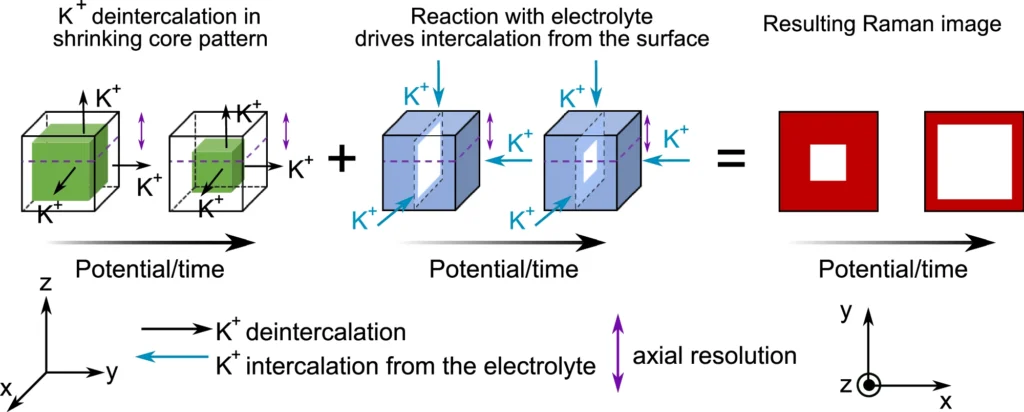
The mechanism of concurrent open educational resource pathways is explained:
The simultaneous routes of OER encompass several crucial intermediates, including hydroxyl radicals and superoxide species. These intermediates arise and diminish at various phases of the reaction, contingent upon the catalyst and ambient conditions. High-speed Raman imaging facilitates the real-time monitoring of these intermediates, providing a detailed sequential analysis of the oxygen production process.
This real-time data is essential for tuning catalysts since it identifies the most efficient paths and those that lead to undesirable side reactions.
Influence on Catalyst Design:
Comprehending these simultaneous channels creates new opportunities for catalyst design. Armed with this knowledge, researchers may create catalysts that promote the most efficient reaction pathways while reducing energy dissipation. This has significant implications for enhancing the performance of electrolyzers, fuel cells, and other technologies dependent on OER.
Customizing catalysts for specific routes enhances the efficiency of energy conversion processes, thereby lowering costs and improving the viability of renewable energy systems.
Obstacles in High-Speed Raman Imaging of Oxygen Evolution Reaction:
Notwithstanding its benefits, high-speed compressive Raman imaging presents certain obstacles. The technique necessitates highly specialized apparatus and computer resources, rendering it less accessible to all research laboratories. The intricacy of analyzing extensive datasets can impede the discovery process.
Nevertheless, continual progress in machine learning and data analysis is facilitating the resolution of these difficulties, making this technology more scalable and user-friendly.
The Role of Machine Learning in Raman Data Analysis:
Machine learning is becoming increasingly vital in analyzing the extensive datasets produced by high-speed Raman imaging. AI systems can swiftly scrutinize data, identifying patterns and correlations that might otherwise go unnoticed.
This accelerates the analytical procedure and facilitates the identification of novel reaction pathways, thereby elucidating OER dynamics. Potentiostatic holding experiments.

Applications Beyond Open Educational Resources: Expanding the Use of Compressive Raman Imaging
Although OER is a primary emphasis, high-speed compressive Raman imaging possesses wider applications. We can use it to explore additional electrochemical reactions related to battery technology, fuel cells, and corrosion science. Its adaptability makes it an effective tool for promoting a variety of renewable energy technologies.
Future Opportunities for OER Research Using Raman Imaging:
The prospects for OER research utilizing high-speed compressive Raman imaging are favorable. With technological advancements and increased accessibility, we might anticipate further improvements in understanding intricate electrochemical processes. These breakthroughs will probably expedite the creation of novel materials and technologies for sustainable energy.
Final Assessment:
High-speed compressive Raman imaging has transformed our understanding of the oxygen evolution reaction by revealing simultaneous channels that were previously difficult to detect. This advancement has significant implications for the development of more efficient catalysts, thereby promoting renewable energy technology. This advancing technology will increasingly be essential in realizing the complete potential of OER and other electrochemical processes.
Frequently Asked Questions:
1). What is OER’s function in renewable energy technologies? OER is essential for water splitting in electrolyzers and fuel cells, facilitating hydrogen synthesis, a sustainable energy source.
2). What distinguishes high-speed compressive Raman imaging from conventional methods? It records real-time chemical processes with outstanding speed and resolution, facilitating the observation of numerous simultaneous pathways.
3). What is the significance of examining concurrent OER pathways? Comprehending various chemical pathways facilitates process optimization, resulting in enhanced energy conversion systems.
4). What obstacles persist in the application of Raman imaging for OER? The technology is costly and necessitates advanced data analysis; however, progress in machine learning is aiding in surmounting these obstacles.
5). What other domains might utilize this technology? Battery research, corrosion analysis, and many electrochemical processes use compressive Raman imaging in addition to OER.
For more chemistry blogs, visit chemistry Master

